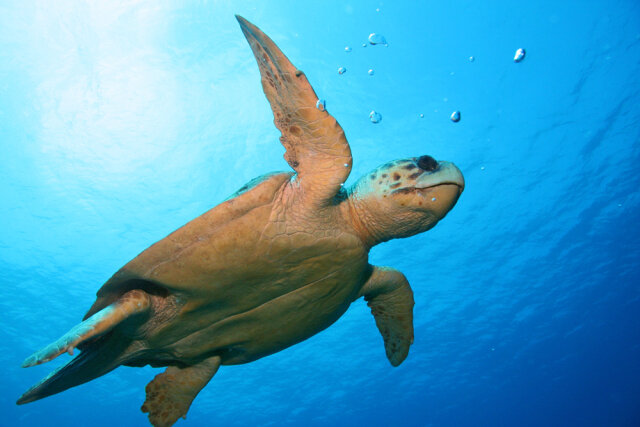New Loggerhead Red List Assessments Published
A loggerhead turtle (Caretta caretta). © Mito Paz / Marine Photobank
A new IUCN Red List Assessment of the loggerhead sea turtle (Caretta caretta) is now available online.
The assessment was completed by the Marine Turtle Specialist Group of the IUCN Species Survival Commission, a global network of sea turtle experts. This is the second sea turtle species (after the leatherback turtle, Dermochelys coriacea) that has been assessed at both the global and subpopulation levels using IUCN Red List Criteria. Red List assessments at the subpopulation level are much more meaningful for conservation planning than those done solely at the global scale, especially for wide-ranging species like sea turtles.
Globally, the loggerhead turtle is now listed as Vulnerable. The 10 loggerhead subpopulations have been assigned to categories ranging from “Critically Endangered” to “Least Concern,” representing in most cases a change from the “Endangered” category to which the species as a whole was assigned in the previous assessment from 1996. Given the increasing use of the IUCN Red List to inform conservation priorities in a variety of contexts, we want to clarify some aspects of the Red List in order to avoid misinterpretations about the status of those loggerhead subpopulations that are now listed as “Near Threatened” or “Least Concern.”
The IUCN Red List Categories and Criteria represent one approach for assessing and comparing the conservation status of very different species, with a specific aim to identify species and subpopulations facing imminent or high risk of extinction globally based on past, current, and expected future conditions and anthropogenic factors.
Loggerhead subpopulations that have been newly listed in the categories “Near Threatened” or “Least Concern” indicate that those subpopulations are not at imminent/high risk of extinction. However, this evaluation is based on their present situation, which takes into account the results of past conservation efforts, many of which have been in place for decades. In this respect, the current status of these subpopulations represents a measure of the success of past conservation efforts. For this reason, these subpopulations need to be considered to be conservation-dependent. Any decrease of the current conservation effort would very likely be detrimental. Indeed, it is only because of such prolonged conservation efforts that some loggerhead subpopulations are now being categorized as “Near Threatened” and “Least Concern” rather than higher categories of threat like “Vulnerable,” “Endangered,” and “Critically Endangered.” Moreover, within a subpopulation categorized as “Least Concern” or “Near Threatened” there may still be sea turtle stocks that are facing a high risk of extinction at a national or local level.
Red List assessments are updated regularly to reflect the most current and best available data, and as such the Red List status of loggerheads may change with time. All the loggerhead subpopulations must be monitored and studied further in order to assure that conservation strategies and interventions are adjusted to respond to possible future changes. Red List assessments are policy relevant rather than policy prescriptive, and to derive adequate policies at regional or national levels may require many different types of assessments.
Based on the present state of knowledge, all loggerhead subpopulations are in need of intensive conservation measures to improve or to maintain their current conservation status.

